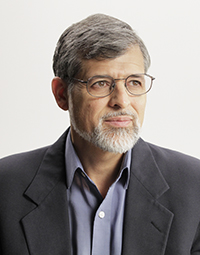
Date: Tue Jun 26, 2018
Time: 1:15 PM - 3:00 PM
Moderator: Daniel Kindred
Digital tools and data collection have become standard in a wide variety of present day agricultural operations. An array of digital tools, such as high resolution operational mapping, remote sensing, and farm management software offer solutions to many of the problems in modern agriculture. These technologies and services can, if implemented correctly, provide both immediate and long term agronomic value. A growing number of producers in Ohio and around North America question the proper method of initiating and/or advancing their investment in digital agriculture technologies and services due to multiple associated challenges. Sometimes, technology providers boast unachievable benefits while field-scale savings can make the perceived return on investment unclear. This has led to a void between producers and technology providers that continues to grow as technology advances.
An attempt was made to close this void through utilizing a myriad of available technologies to document data that can be collected through commercial technologies by farmers. This project followed the data collection process for a single field, and specifically for a single corn plant in order to understand the type and total amount of data being collected. A total of 18.5 GB of data was collected that included 2,476 individual files. These files were then categorized and ranked according to ease of adoption, added value, amount of generated data, and various other categories. The highest rankings in these categories signify the types of technologies found most valuable to the production of this corn plant. Key data layers used by the famer during the 2017 growing season were as-planted, yield, imagery, seeding Rx and weather. Post-harvest analyses provided a means to separate data layers or files that provided value and ROI to the farmer. While impractical in commercial application, this platform served as a means to encourage adoption of these technologies and a determination of the many ways that data can be collected, analyzed, and acted upon in the current state of digital agriculture.

Image/video processing for fruit detection in the tree using hard-coded feature extraction algorithms have shown high accuracy on fruit detection during recent years. While accurate, these approaches even with high-end hardware are still computationally intensive and too slow for real-time systems. This paper details the use of deep convolution neural networks architecture based on single-stage detectors. Using deep-learning techniques eliminates the need for hard-code specific features for specific fruit shapes, color and/or other attributes. This architectures take the input image and divides into AxA grid, where A is a configurable hyper-parameter that defines the fineness of the grid To each grid cell an image detection and localization algorithm is applied. Each of those cells is responsible to predict bounding boxes and confidence score for fruit (apple and pear in the case of this study) detected in that cell. We want this confidence score to be high if a fruit exists in a cell, otherwise to be zero, if no fruit is in the cell. More than 100 images of apple were taken. Each tree image with approximately 50 fruits, that at the end resulted on more than 5000 images of apple and pear fruits each. Labeling images for training consisted on manually specifying the bounding boxes for fruits, where (x, y) are the center coordinates of the box and (w, h) are width and height. This architecture showed an accuracy of more than 90% fruit detection. Based on correlation between number of visible fruits, detected fruits on one frame and the real number of fruits on one tree, a model was created to accommodate this error rate. Processing speed is higher than 10FPS which is fast enough for any grasping/harvesting robotic arm or other real-time applications.
Compact hyperspectral sensors compatible with UAV platforms are becoming more readily available. These sensors provide reflectance in narrow spectral bands while covering a wide range of the electromagnetic spectrum. However, because of the narrow spectral bands and wide spectral range, hyperspectral data analysis can benefit greatly from data mining and machine learning techniques to leverage its power. In this study, rainfed corn was grown during the 2017 growing season using four nitrogen treatments (between 0 and 200 kg N/ha using 67 kg/ha increment steps) where 200 kg/ha represented the economically optimum nitrogen rate (EONR). This design generated four ordinal classes of N deficiency (dN) that were confirmed using chlorophyll readings (SPAD), leaf nitrogen content, and soil nitrate all collected at V5 corn growth stage, on the same day the hyperspectral data was collected. Hyperspectral images were collected using a line scanner sensor on board a hexacopter UAV platform. Following radiometric correction, image segmentation, spectral extraction and preprocessing, eight machine learning algorithms were compared for their accuracy in determining the four classes of nitrogen deficiency levels based on the DEONR (dN =dEONR). These algorithms are the logistic regression (LR), support vector machine (SVM), random forest (RF), gradient boosting (GB), naïve Bayes (NB), decision tree (DT) and Multi-Layer Perceptron (MLP). A confusion matrix based on a 30% test set (unseen by the models) was used to determine the performance of these classifiers and to illustrate the type and magnitude of errors for each classification method. Narrow-bands and simulated broad-band vegetation indices (VIs) were also derived from the hyperspectral data and compared to machine learning algorithms for the prediction of dN. Our findings confirm the challenge of using VIs to assess early season (V5) corn nitrogen status. VIs correctly estimated N stress on only 50% of plant samples, and caused nearly 30% of plants to be under-fertilized. On the other hand, hyperspectral machine learning significantly improved the assessment of corn nitrogen stress at V5, and achieved more than 90% classification accuracy. Particularly, SVM, LR, MLP and GB showed promising results. These findings illustrate the huge potential for UAV-compatible hyperspectral sensors to improve in-season corn nitrogen management for timely variable rate sidedress application.

To increase the utilization of satellite remote sensing data in precision agriculture, it is necessary to retrieve the most relevant variables from the satellite signals so that the retrievals can be directly utilized by agricultural management entities. The variables that make up the state vector description of existing crop growth models provide inherent relevance to on-farm decision making because they can be used to predict future crop status based on changing farm inputs. In this study, the information content of MODIS spectral surface reflectance measurements with respect to the state variables in the STICS crop growth model for maize is analyzed. Specifically, it is shown that the MODIS measurements can predict the state variables of an ensemble average of STICS crop growth simulations with R2 values of up to 0.75 using a bidirectional long short-term memory (BLSTM) network. The analysis is performed using a training, validation, test data division scheme typical in machine learning using county-median measurements from 36 counties across the United States; data from 2006, 2008, 2010, 2012, and 2014 is used for training, data from 2005, 2009, and 2011 is used for validation and data from 2007 and 2013 is used for testing. Significant correlation of the harvested organ biomass, subsurface soil water, and phenological stage state variables with the MODIS measurements is shown in this study, implying that the remote sensing signal can be used for significantly more than for retrieving the leaf area index.
Machine learning is increasingly used in data analytics and is gaining popularity in agronomy as a new way of inferring and interpreting data to forecast and predict yields. This study evaluated the importance of multiple variables in corn yield predictions using regression analysis on five years historical yield data from multiple fields located in Canada using hybrid machine learning techniques such as Random Forest and TreeNet gradient boosting algorithms as an additional method for rating variable importance in factors predicting yields. Predictor variables that were used in the analysis were harvest locations recorded by the grain harvester, nitrogen applied at planting, top dressing and the total nitrogen applied, topdressing, remote sensing derived indices such as NDVI, SAVI, NSI and apparent electrical conductivity at shallow and deep levels recorded for the 2013 growing season. Our analysis revealed improved coefficient of determination, when we changed the total trees in the RF model from 200 to 1000, from a R2 value of 0.749 to 0.834 with mean absolute deviation improving from 0.7 t/ha to 0.5 t/ha. The model reported top dressing, X,Y locations, SAVI, NDVI, total nitrogen applied, NSI and nitrogen applied at planting as the order of variable importance. We analysed the model using the top six predictors reported by the hybrid model to see if the model outperforms itself with fewer variables for the yield predictions but we did not observed any significant improvement in the model output. We report analysis for the past six years data between 2011-2016.
Precision agriculture technology adoption has permitted farmers to not only receive value for their farm operation but also collect a significant amount of data. In recent years, telemetry has become standard technology on agricultural machinery permitting automated means to move data from machines to a cloud environment. Many of this data not provides the farm operation information for evaluation and verification but can be useful to support research focused on crop production best management practices. The objective of this paper is to outline new technologies that bring efficiency to data sharing and management when farmers are working with researchers focused on water quality, crop response and similar type topics of interest to agriculture. This case study will review the various APPs and software technologies being used in a variable-rate research project by both farmers and university personnel to implement, collect data using precision ag technologies and provide overall analyses. This work will also outline protocols being used to address farmers’ concerns over public record requests when public institutions are involved as a data handler and playing a role in the research. Methods include using a centralized data repository to collect and organize data and how the university personnel interact with different agriculture cloud technologies to assemble data shared by individual farmers plus sharing of data to graduate students and staff responsible for data summary and analyses. Preliminary results include significant reduction in time collecting data at the farm to support the project plus bringing efficiency to how university personnel access and interact with data collecting from a multitude of farmers and technologies.


Mobile devices advanced adoption has fostered the creation of various messaging applications providing convenience and practicality in general communication. In this sense, new technologies arise bringing automatic, continuous and intelligent features for communication through messaging applications by using web robots, also called Chatbots. Those are computer programs that simulate a real conversation between humans to answer questions or do tasks, giving the impression that the person is talking to someone else and not with a computer program. For agricultural purposes, it is important that the data about field conditions, such as air and soil temperature, air relative humidity, soil moisture, rainfall, wind speed and other relevant variables, be rapid and easily available for use by farm management systems, by specialists, or the farmer itself in decision-making processes. AgronomoBot was developed focused on the search and display of data acquired from a Wireless Sensor Network deployed on a vineyard. It is based on Telegram Bot API and is able to access information collected by eKo field sensors, bringing it back to a user through interaction over the Telegram application. The IBM Watson cognition services platform was also used for improving the user experience by enabling the use of natural language during the conversation experience, providing intention detection. Further developments are planned for AgronomoBot, such as the expansion to other messaging platforms, the implementation of speech communication capacity, image classification and continuous data analysis. It is hoped that with analytical capacity over the mass of available data, it becomes possible to work towards the prevention of harmful situations to agricultural productions, early detection of diseases in crops, energy and water waste reduction, and advanced management capabilities for the farmer.

